Histamine Friendly Shish Kebabs
A low histamine option that will brighten up your summer!
When I am brainstorming recipes, I try to think of things that you could make easily, but are so good that you don’t even notice that it is a food intolerance friendly recipe. I wanted to make one that was not just another simple meat-veggie-starch medley— and not to toot my own horn, but I succeeded.
You’ll love this unique and flavorful way to incorporate low histamine ingredients.
The key to keeping meals low histamine, is to avoid ripening and aging, especially meat. For this recipe, I used non-aged fresh beef. You can use chicken, especially if on an elimination diet, or non-aged lamb, or as I did, non-aged beef. Whatever meat you choose, it’s crucial to buy fresh meat. It’s even more important to keep it cold, then cut it and freeze it as soon as possible. Remember, Histamines increase as the food item ripens and or ages, so we want to “freeze” that clock as much as we can. I plan to share a blog post early next month where I will get into how I select, prepare, and store meat- including what to look for in the store and how to safely handle meat. Stay tuned for that!
Skewers?
Now, what makes a shish kebab, a shish kebab? Well, the skewer of course. But you can skip the skewers and bake this a sheet pan meal. It would be delicious served over some white rice, skewered or not. You can also use wooden skewers, but be sure to soak them in water for at least 30 minutes to prevent burning. I prefer metal skewers as they are reusable. Be careful skewering the meat and vegetables especially when working with frozen meat. I thaw in cold water just long enough that I can get the skewer through. We do “un-skewer” the leftovers to freeze then “re-skewer” after reheating in the air-fryer or oven on a baking sheet.
Tips and Omissions
As always, cool quickly and store in the freezer in airtight containers. We like the size of these ones although I have to remove the skewer to fit in these. We’ve found that freezing these leftovers makes them extra juicy reheated instead of drying out. See below for my reheating tips as well. I tried both styles of baking racks that I have (one has folding “legs” and the other does not) and both worked great. It is good to slice the zucchini into thicker slices than the turnips so they cook more equally. You also have the option of serving these with fresh white rice. Try adding your garlic infused oil for some low-everything extra flavor! For low-salicylate or elimination diets, omit rosemary and use only salt. If you are finding that you are sensitive to sulfur or are unable to find beef that works for you, try this recipe with skinless chicken breast. Cook the recipe the same way– Just make sure that internal temperature is 165*F.
I have seen conflicting information regarding which bell pepper color is the most gentle— some say green, some say red, yellow, or orange. We have not noticed a huge difference when trying these with the different colors. It is definitely something to keep track of in that handy food symptom tracker you downloaded last week from my ko-fi shop.
Alternative Cooking Methods
I baked these in the oven, but there are a few ways you can cook these depending on your preference. If you have a grill, grill kebabs for 10-15 minutes on medium-high heat. You should turn every few minutes to ensure even cooking and try to avoid over-charring the vegetables. You can also broil these on high for about 10–12 minutes, turning once halfway through, until the meat is cooked through and vegetables are lightly charred. If you plan to use the broiler, be sure to use aluminum foil and not parchment paper and ensure your baking racks and sheets are broiler safe.
Reheating from Frozen Instructions:
Preheat your oven or air fryer to 350°F (177°C).
For oven: Use this method if you froze on the skewers. Place the kebab pieces on a baking sheet. Cover loosely with foil to prevent them from drying out. Heat for about 10–15 minutes, or until warmed. Re-skewer if desired.
For air fryer: Cover lightly (a microwave-safe lid or another plate works well) and microwave in 30-second intervals on defrost mode until removable from freezer container. Place the kebab pieces in air fryer. Heat for about 5-7 minutes, or until warmed. Re-skewer if desired.
Alternative- Skillet Method:
Heat a little oil or water in a skillet over medium-low heat. Add the kabob pieces (off the skewers) and stir occasionally until warmed through. Covering with a lid helps keep them moist.
Indeed, the word of God is living and effective, sharper than any two-edged sword, penetrating even between soul and spirit,
joints and marrow, and able to discern reflections and thoughts of the heart.
Hebrews 4:12 (NABRE)
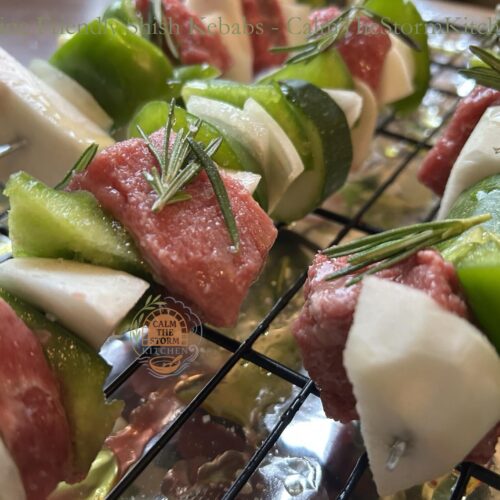
Histamine Friendly Shish Kebabs
Equipment
- 4-8 Skewers (Optional)
- 1-2 Baking racks (Optional)
- 1-2 Baking sheets (Optional)
Ingredients
- 2 pounds beef lamb, or chicken (fresh, not aged), cut into 1½-inch cubes
- 2 green bell peppers cut into large pieces
- 2 small zucchini sliced into thick rounds
- 2 medium turnips peeled and cut into chunks
- 1 large white onion cut into chunks
- 2 tablespoons olive oil or garlic-infused olive oil optional
- 2 teaspoons sea salt to taste
- Fresh rosemary finely minced (optional, based on tolerance)
Instructions
- Preheat your oven to 400°F (200°C).
- Line baking sheet with aluminum foil (if using broiler) or parchment paper and baking rack (optional).
- Cut the meat into uniform 1½-inch cubes.
- Peel and chop the turnips into similar-sized chunks.
- (Optional: Steam turnips for 5 minutes to soften slightly before assembling.)
- Cut the green bell peppers and white onion, and slice the zucchini into thick rounds (about ½-inch thick). into large, even pieces.
- Assemble skewers, alternating meat, turnip, green pepper, onion, and zucchini pieces. (Or spread evenly on parchment paper lined baking sheet if not using skewers)
- Brush lightly or drizzle with olive oil or garlic-infused olive oil, if using.
- Sprinkle with sea salt and rosemary if tolerated.
- Line a baking sheet with parchment paper or foil. Place the assembled skewers on the baking sheet.
- Bake for 18–22 minutes, flipping halfway through, until the meat is cooked through and vegetables are tender.
- Serve immediately or cool slightly and freeze in airtight containers.
Notes
- For strict low-salicylate needs, peel all vegetables, omit rosemary and use only salt.
- Always use fresh meat to minimize histamine buildup. Prepare and cook promptly after purchasing.
- Optionally, serve with freshly made white rice.
- Cool leftovers quickly and store in freezer in airtight containers.
- Since zucchini cooks a little faster than turnips, slicing it into thicker pieces helps them roast at about the same speed without overcooking.
- If using wooden skewers, soak them in water for at least 30 minutes to prevent burning.
- Broiler:
Preheat the broiler to high. Place the assembled kebabs on a foil-lined baking sheet. Broil for about 10–12 minutes, turning once halfway through, until the meat is cooked through and vegetables are lightly charred. - Outdoor Grill:
Preheat the grill to medium-high heat. Grill kebabs for about 10–15 minutes, turning every few minutes to ensure even cooking. Watch closely to avoid over-charring the vegetables.
Reheating from Frozen Instructions:
Preheat your oven or air fryer to 350°F (177°C).Remove the meat and veggies from the skewers and place them in a microwave-safe dish. Cover lightly (a microwave-safe lid or another plate works well) and microwave in 30-second intervals on defrost mode until removable from freezer container. For oven: Place the kebab pieces on a baking sheet. Cover loosely with foil to prevent them from drying out. Heat for about 10–15 minutes, or until warmed. For air fryer: Place the kebab pieces in air fryer. Heat for about 5-7 minutes, or until warmed.
Alternative- Skillet Method:
Heat a little oil or water in a skillet over medium-low heat. Add the kabob pieces (off the skewers) and stir occasionally until warmed through. Covering with a lid helps keep them moist.
- Calories: 350–400 kcal
- Protein: 25–30 g
- Total Fat: 20–25 g
- Saturated Fat: 5–7 g
- Carbohydrates: 10–15 g
- Fiber: 2–3 g

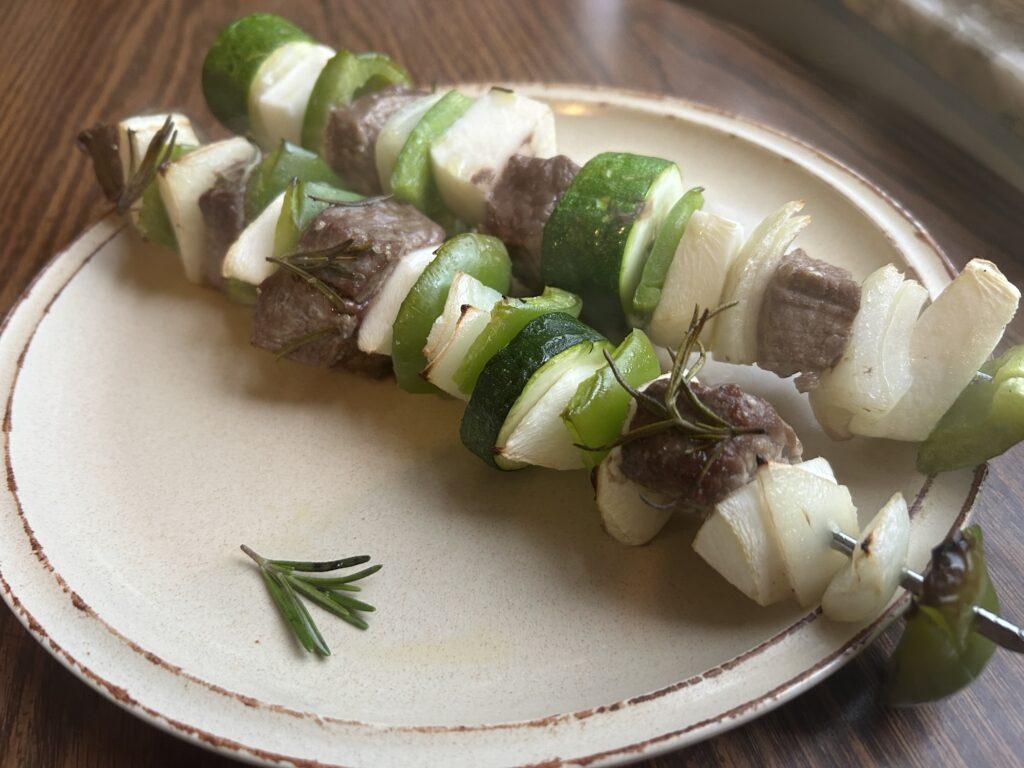
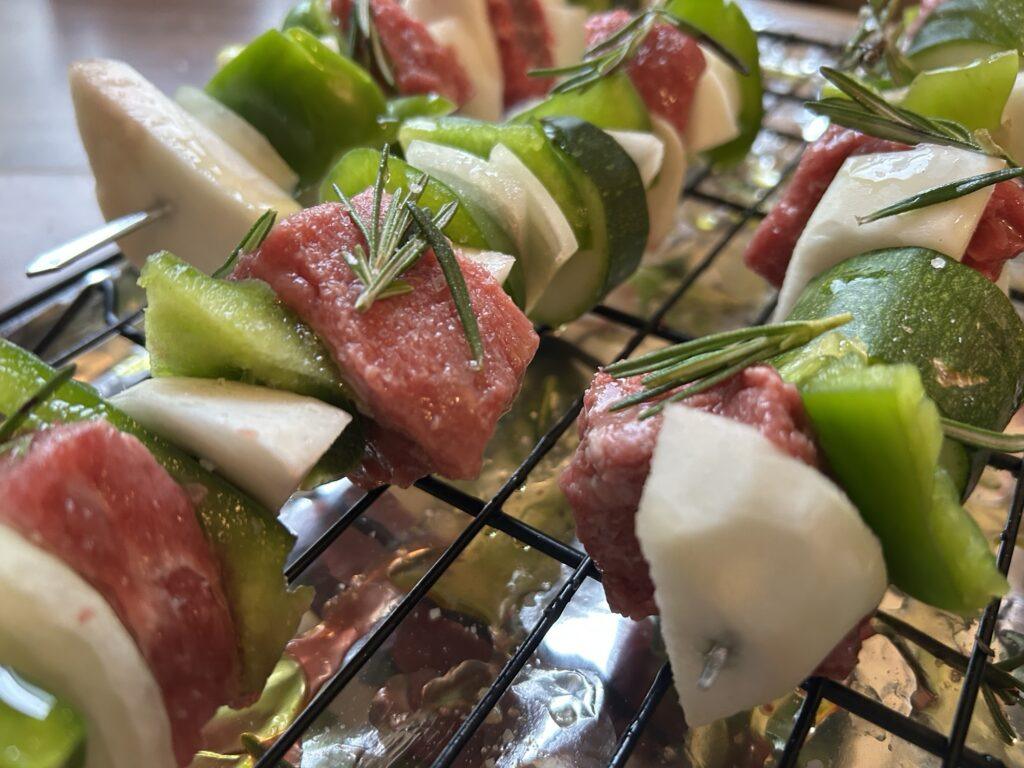
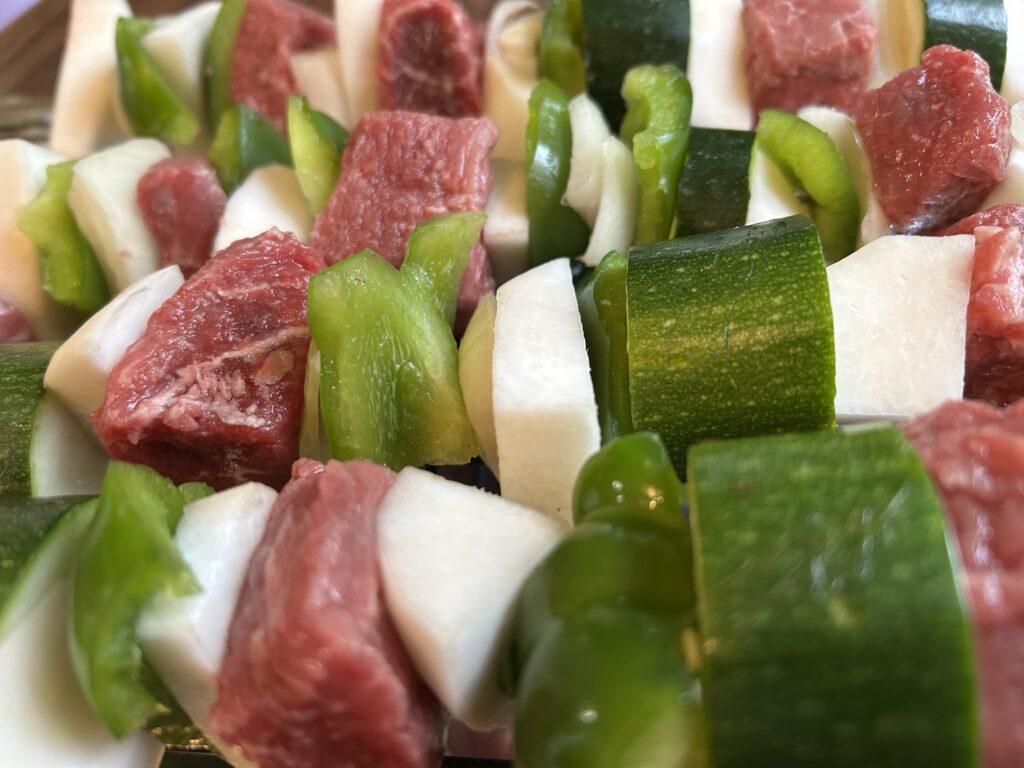
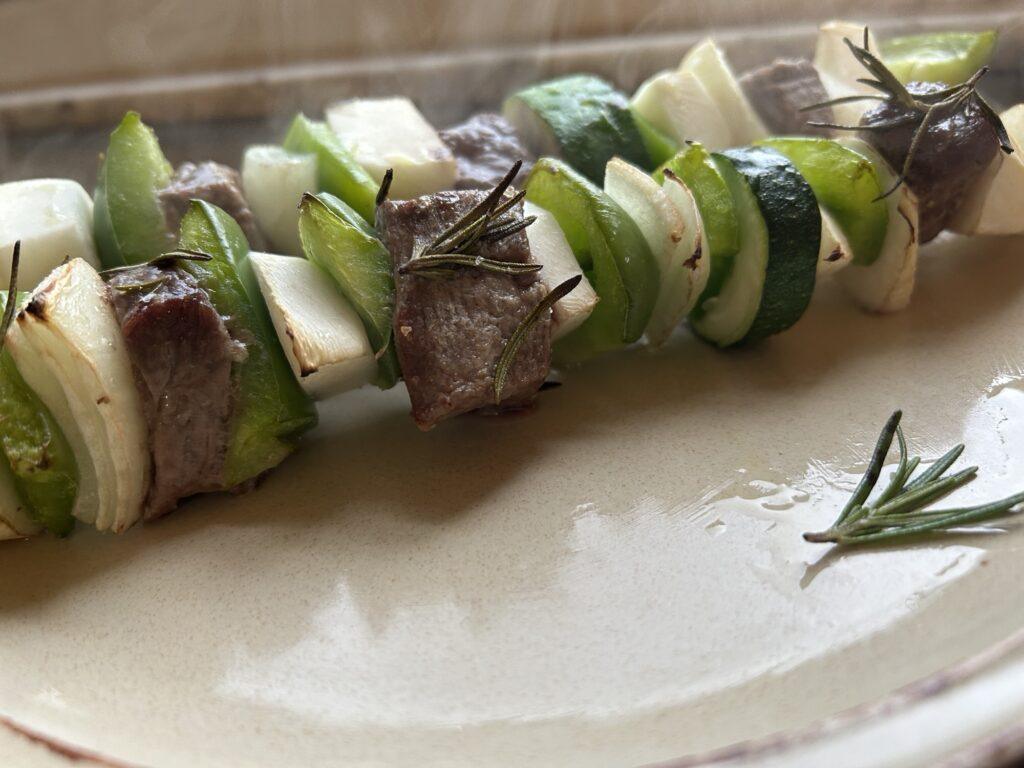
Leave a Reply